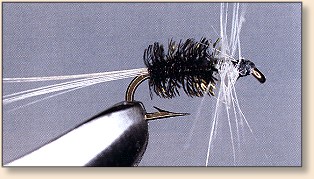Peg's Midge Dry
By Don Holbrook
Excerpt from Midge Magic by Don
Holbrook and Ed Koch, Published by Stackpole Press.
Peacock Patterns
 When I was first taught to tie flies at the Carlisle Fish and
Game winter program, the instructors marked patterns in our
books that they thought we should try. Otherwise, we probably
would have tied the whole book. Quite a few of them were
peacock-bodied flies, and I always did well on them. Add to
this the fact that peacock feathers seem to work magic when
you turn them in the light and watch the iridescent colors change
before your eyes. I don't care what it is - if it has peacock in
it, I like it.
When I was first taught to tie flies at the Carlisle Fish and
Game winter program, the instructors marked patterns in our
books that they thought we should try. Otherwise, we probably
would have tied the whole book. Quite a few of them were
peacock-bodied flies, and I always did well on them. Add to
this the fact that peacock feathers seem to work magic when
you turn them in the light and watch the iridescent colors change
before your eyes. I don't care what it is - if it has peacock in
it, I like it.
Probably one of my early reasons for not fishing drys was that
I was not very good at casting. I only owned heavy rods, which
didn't help on these small streams, but my own ineptness was a
bigger problem. Still, I was somewhat fascinated by the many
rising fish when the midges hatch in the early evening on the
Big Spring Creek, near Newville, Pennsylvania. Occassionally,
I'd hear the splashing of a fish being caught and would look
around to see a lady releasing a trout back into the stream. She
had a little dog that dutifully followed her along the bank (no
wading was allowed in this section) and waited while she cast to
the next rising fish. She didn't miss too many, and it got to
where I would step back when she got to the area I was fishing and
invite her to fish through. She did, and she caught most of the
risers. I didn't perceive this as a problem, as I was normally
fishing nymphs, so we were after different quarry - and I wasn't
having much success on the top, anywhere. This went on for two
or three years, with not much more than a polite hello.
Then, one very hot July evening in 1977, I had been catching fish
until they started rising, but then I couldn't touch a fish. I
even resorted to fishing dry flies on top, to no avail. Hearing
that now familiar noise, I looked around to see her releasing another
trout. She worked her way up to where I was waiting. I couldn't
take it any longer. I just had to ask what she was using. To my
great surprise, she showed me a little size 26 dry fly with a
peacock herl body and white hackle and tails. She gave me one and
made me promise not to show it to anyone, and I didn't - until now.
The lady is Peg Myers, from Newville. She doesn't tie these flies - her
husband, Barry, does it. I suspect it's really his pattern, but I'm
not going to ask. She may have another secret one I can weasel out of
her some day. This is another pattern I wouldn't be without.
Materials: Peg's Midge Dry
- Hook: Mustad size 24 94840.
- Thread: Black.
- Tail: 3 or 4 white or palest cream hackle.
- Body: Very small peacock herl.
- Hackle: Small white hackle.
Tying Steps:


1. Insert a size 24 Mustad 94840 hook in the vise, and attach tying thread near
the hook point. Wrap the thread to the rear, just above the barb. Using three
or four white or palest cream hackle fibers for the tail, tie them in at this
point by holding them on the side of the hook and letting the thread roll them
on top, as in the chapter on topwater patterns. Make them twice the hook
length. Try to use only three turns.

2. Select the smallest peacock herl you can find, and tie it in by the
tip at the point where the thread hangs. Gently stroke the fibers on
the stem if you like them to stand up. Take two turns of thread to the
rear, which should put you at the point where the tail was tied in. Return
the thread to the front in tight turns, stopping just far enough behind the
eye for three hackle wraps and a tiny head.
|









